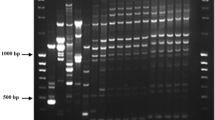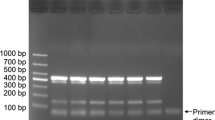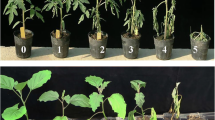Abstract
Ralstonia solanacearum causes bacterial wilt disease in many plant species, including mulberry. Here, we used a suppression subtractive hybridization (SSH) approach to identify specific DNA fragments in R. solanacearum race 5-biovar 5. The genome of the R. solanacearum M7 strain was subtracted from that of the GMI1000 strain, resulting in the identification of 85 subtracted fragments. The primer set MG67-F/R for identification of Ralstonia solanacearum race 5-biovar 5 strains was designed on the basis of the clone MG67 sequence. Furthermore, a multiplex PCR was developed by using the primer set MG67-F/MG67R in combination with the species-specific primer pair 759/760. A 156 bp r5-bv5-specific fragment, together with a 282 bp species-specific fragment, was amplified from all tested R. solanacearum r5-bv5 strains. The sensitivity of the multiplex PCR made it possible to detect concentrations as low as 102 CFU ml−1 of pure culture. Moreover, the r5-bv5-specific multiplex PCR was successfully applied to detect Ralstonia solanacearum race 5-biovar 5 strains in diseased mulberry samples. Therefore, the multiplex PCR assay can be used as a reliable diagnostic technique to enable researchers to rapidly identify isolates of R. solanacearum race 5-biovar 5.





Similar content being viewed by others
Abbreviations
- r:
-
Race
- bv:
-
Biovar
- IS:
-
Insertion sequences
- SSH:
-
Suppression subtractive hybridization
References
Bernier, S. P., & Sokol, P. A. (2005). Use of suppression-subtractive hybridization to identify genes in the Burkholderia cepacia complex that are unique to Burkholderia cenocepacia. Journal of Bacteriology, 187, 5278–5291.
Boudazin, G., Le Roux, A. C., Josi, K., Labarre, P., & Jouan, B. (1999). Design of division specific primers of Ralstonia solanacearum and application to the identification of European isolates. European Journal of Plant Pathology, 105, 373–380.
Buddenhagen, I., Sequeira, L., & Kelman, A. (1962). Designation of races in Pseudomonas solanacearum. Phytopathology, 52, 726.
DeShazer, D. (2004). Genomic diversity of Burkholderia pseudomallei clinical isolates: subtractive hybridization reveals a Burkholderia mallei-specific prophage in B. pseudomallei 1026b. Jounal of Bacteriology, 186, 3938–3950.
Fegan, M., Holoway, G., Hayward, A. C., & Timmis, J. (1998a). Development of a diagnostic test based on the polymerase chain reaction (PCR) to identify strains of R. solanacearum exhibiting the biovar 2 genotype. In P. Prior, C. Allen, & J. Elphinstone (Eds.), Bacterial wilt disease—Molecular and ecological aspects (pp. 34–43). Berlin: Springer.
Fegan, M., Taghavi, M., Sly, L. I., & Hayward, A. C. (1998b). Phylogeny, diversity and molecular diagnostics of Ralstonia solanacearum. In P. Prior, C. Allen, & J. Elphinstone (Eds.), Bacterial wilt disease—Molecular and ecological aspects (pp. 19–33). Berlin: Springer.
Fegan, M., & Prior, P. (2005). How complex is the “Ralstonia solanacearum species complex”. In C. Allen, P. Prior, & A. C. Hayward (Eds.), Bacterial wilt disease and the Ralstonia solanacearum species complex (pp. 449–462). St Paul: APS Press.
Galas, D. J., & Chandler, M. (1989). Bacterial insertion sequences. In D. E. Berg & M. M. Howe (Eds.), Mobile DNA (pp. 109–162). Washington, D.C.: American Society for Microbiology.
Gillings, M., Fahy, P., & Davies, C. (1993). Restriction analysis of an amplified polygalacturonase gene fragment differentiates strains of the phytopathogenic bacterium Pseudomonas solanacearum. Letters in Applied Microbiology, 17, 44–48.
Guidot, A., Elbaz, M., Carrère, S., Siri, M. I., Pianzzola, M. J., Prior, P., et al. (2009). Specific genes from the potato brown rot strains of Ralstonia solanacearum and their potential use for strain detection. Phytopathology, 99, 1105–1112.
Guidot, A., Prior, P., Schoenfeld, J., Carrère, S., Genin, S., & Boucher, C. (2007). Genomic structure and phylogeny of the plant pathogen Ralstonia solanacearum inferred from gene distribution analysis. Jounal of Bacteriology, 189, 377–387.
Harakava, R., & Gabriel, D. W. (2003). Genetic differences between two strains of Xylella fastidiosa revealed by suppression subtractive hybridization. Applied and Environmental Microbiology, 69, 1315–1319.
Hayward, A. C. (1964). Characteristics of Pseudomonas solanacearum. Journal of Applied Bacteriology, 27, 265–277.
Hayward, A. C. (1991). Biology and epidemiology of bacterial wilt caused by Pseudomonas solanacearum. Annual Review of Phytopathology, 29, 67–87.
Hayward, A. C. (1994). Systematics and phylogeny of Pseudomonas solanacearum and related bacteria. In A. C. Hayward & G. L. Hartman (Eds.), Bacterial wilt: The disease and its causative agent, Pseudomonas solanacearum (pp. 123–135). United Kingdom: CAB International.
He, L. Y., Sequeira, L., & Kelman, A. (1983). Characteristics of strains of Pseudomonas solanacearum. Plant Disease, 67, 1357–1361.
Horita, M., Yano, K., & Tsuchiya, K. (2004). PCR-based specific detection of Ralstonia solanacearum race 4 strains. Journal of General Plant Pathology, 70, 278–283.
Ito, S., Ushijima, Y., Fujii, T., Tanaka, S., Kameya-Iwaki, M., Yoshiwara, S., et al. (1998). Detection of viable cells of Ralstonia solanacearum in soil using a semiselective medium and a PCR technique. Journal of Phytopathology, 146, 379–384.
Jeong, E. L., & Timmis, J. N. (2000). Novel insertion sequence elements associated with genetic heterogeneity and phenotype conversion in Ralstonia solanacearum. Jounal of Bacteriology, 182, 4673–4676.
Juíz-Río, S., Osorio, C. R., de Lorenzo, V., & Lemos, M. L. (2005). Subtractive hybridization reveals a high genetic diversity in the fish pathogen Photobacterium damselae subsp. piscicida: evidence of a SXT-like element. Microbiology, 151, 2659–2669.
Kelman, A. (1954). The relationship of pathogenicity in Pseudomonas solanacearum to colony appearance on a tetrazolium chloride medium. Phytopathology, 44, 693–695.
Lavie, M., Seunes, B., Prior, P., & Boucher, C. (2004). Distribution and sequence analysis of a family of type Ill-dependent effectors correlate with the phylogeny of Ralstonia solanacearum strains. Molecular Plant-Microbe Interactions, 17, 931–940.
Lee, Y.-A., & Wang, C.-C. (2000). The design of specific primers for the detection of Rastonia solanacearum in soil samples by polymerase chain reaction. Botanical Bulletin Academia Sinica, 41, 121–128.
Lebeau, A., Daunay, M.-C., Frary, A., Palloix, A., Wang, J.-F., Dintinger, J., et al. (2011). Bacterial wilt resistance in tomato, pepper, and eggplant: genetic resources respond to diverse strains in the Ralstonia solanacearum species complex. Phytopathology, 101, 154–165.
Li, Z.-F., Wu, S.-L., Bai, X.-F., Liu, Y., Lu, J.-F., Liu, Y., et al. (2011). Genome sequence of the tobacco bacterial wilt pathogen Ralstonia solanacearum. Journal of Bacteriology, 193, 6088–6089.
Opina, N., Tavner, F., Hollway, G., Wang, J.-F., Li, T.-H., Maghirang, R., et al. (1997). A novel method for development of species and strain-specific DNA probes and PCR primers for identifying Burkholderia solanacearum (formerly Pseudomonas solanacearum). Asia and Pacific Journal of Molecular Biology and Biotechnology, 5, 19–33.
Mills, D., Russell, B. W., & Hanus, J. W. (1997). Specific Detection of Clavibacter michiganensis subsp. sepedonicus by Amplification of Three Unique DNA Sequences Isolated by Subtraction Hybridization. Phytopathology, 87, 853–861.
Pastrik, K.-H., Elphinstone, J. G., & Pukall, R. (2002). Sequence analysis and detection of Ralstonia solanacearum by multiplex PCR amplification of 16S–23S ribosomal intergenic spacer region with internal positive control. European Journal of Plant Pathology, 108, 831–842.
Pegg, K. G., & Moffett, M. (1971). Host range of the ginger strain of Pseudomonas solanacearum in Queensland. Australian Journal of Experimental Agriculture and Animal Husbandry, 11, 696–698.
Poussier, S., Prior, P., Luisetti, J., Hayward, C., & Fegan, M. (2000). Partial sequencing of the hrpB and endoglucanase genes confirms and expands the known diversity within the Ralstonia solanacearum species complex. Systematic and Applied Microbiology, 23, 479–486.
Prior, P., & Fegan, M. (2005a). Recent development in the phylogeny and classification of Ralstonia solanacearum. Acta Horticulturae, 695, 127–136.
Prior, P., & Fegan, M. (2005b). Diversity and molecular detection of Ralstonia solanacearum race 2 strains by multiplex PCR. In C. Allen, P. Prior, & A. C. Hayward (Eds.), Bacterial wilt disease and the Ralstonia solanacearum species complex (pp. 405–414). Madison: APS Press.
Qi, M., Nelson, K. E., Daugherty, S. C., Nelson, W. C., Hance, I. R., Morrison, M., et al. (2005). Novel molecular features of the fibrolytic intestinal bacterium Fibrobacter intestinalis not shared with Fibrobacter succinogenes as determined by suppressive subtractive hybridization. Journal of Bacteriology, 187, 3739–3751.
Remenant, B., Coupat-Goutaland, B., Guidot, A., Cellier, G., Wicker, E., Allen, C., et al. (2010). Genomes of three tomato pathogens within the Ralstonia solanacearum species complex reveal significant evolutionary divergence. BMC Genomics, 11, 379.
Salanoubat, M., Genin, S., Artiguenave, F., Gouzy, J., Mangenot, S., Arlat, M., et al. (2002). Genome sequence of the plant pathogen Ralstonia solanacearum. Nature, 415, 497–502.
Sato, M., & Takahashi, K. (1972). Ecological studies on the bacterial blight of mulberry. 1. The overwintering of the pathogen, Pseudomonas mori (Boyer et Lambert) Stevens. Journal Sericult Science Japan, 41, 285–293.
Schonfeld, J., Heuer, H., van Elsas, J. D., & Smalla, K. (2003). Specific and sensitive detection of Ralstonia solanacearum in soil on the basis of PCR amplification of fliC fragments. Applied and Environmental Microbiology, 69, 7248–7256.
Seal, S. E., Jackson, L. A., Young, J. P. W., & Daniels, M. J. (1993). Differentiation of Pseudomonas solanacearum, Pseudomonas syzygii, Pseudomonas pickettii and the blood disease bacterium by partial 16S rRNA sequencing: construction of oligonucleotide primers for sensitive detection by polymerase chain reaction. Journal of General Microbiology, 139, 1587–1594.
Seal, S. E., Taghavi, M., Fegan, N., Hayward, A. C., & Fegan, M. (1999). Determination of Ralstonia (Pseudomonas) solanacearum rDNA subgroups by PCR tests. Plant Pathology, 48, 115–120.
Stevens, P., & van Elsas, J. D. (2010). A putative genomic island, PGI-1, in Ralstonia solanacearum biovar 2 revealed by subtractive hybridization. Antonie Van Leeuwenhoek, 98, 359–377.
Sawada, K., Kokeguchi, S., Hongyo, H., Sawada, S., Miyamoto, M., Maeda, H., et al. (1999). Identification by subtractive hybridization of a novel insertion sequence specific for virulent strains of Porphyromonas gingivalis. Infection and Immunity, 67, 5621–5625.
Takahashi, K., & Sato, M. (1978). The shoot soft rot of mulberry caused by Erwinia carotovora var. carotovora (Jones) dye. Journal of Sericultural Science of Japan, 47, 143–153.
Triplett, L. R., Zhao, Y., & Sundin, G. W. (2006). Genetic differences between blight-causing Erwinia species with differing host specificities, identified by suppression subtractive hybridization. Applied and Environmental Microbiology, 72, 7359–7364.
Villa, J. E., Tsuchiya, K., Horita, M., Natural, M., Opina, N., & Hyakumachi, M. (2005). Phylogenetic relationships of Ralstonia solanacearum species complex strains from Asia and other continents based on 16S rDNA, endoglucanase, and hrpB gene sequences. Journal of General Plant Pahtology, 71, 39–46.
Wang, G. F., Xie, G. L., Zhu, B., Huang, J. S., Liu, B., Kawicha, P., et al. (2010). Identification and characterization of the Enterobacter complex causing mulberry (Morus alba) wilt disease in China. European Journal of Plant Pathology, 126, 465–478.
Weller, S. A., Elphinstone, J. G., Smith, N. G., Boonham, N., & Stead, D. E. (2000). Detection of Ralstonia solanacearum strains with a quantitative, multiplex, real-time, fluorogenic PCR (TaqMan) assay. Applied and Environmental Microbiology, 66, 2853–2858.
Wicker, E., Grassart, L., Coranson-Beaudu, R., Mian, D., Guilbaud, C., Fegan, M., et al. (2007). Ralstonia solanacearum strains from Martinique (French West Indies) exhibiting a new pathogenic potential. Applied and Environmental Microbiology, 71, 6790–6801.
Wicker, E., Lefeuvre, P., de Cambiaire, J.-C., Lemaire, C., Poussier, S., & Prior, P. (2011). Contrasting recombination patterns and demographic histories of the plant pathogen Ralstonia solanacearum inferred from MLSA. ISME Journal. doi:10.1038/ismej.2011.160.
Xu, J., Pan, Z. C., Prior, P., Xu, J. S., Zhang, Z., Zhang, H., et al. (2009). Genetic diversity of Ralstonia solanacearum strains from China. European Journal of Plant Pathology, 186, 6186–6197.
Xue, Q.-Y., Yin, Y.-N., Yang, W., Heuer, H., Prior, P., Guo, J.-H., et al. (2011). Genetic diversity of Ralstonia solanacearum strains from China assessed by PCR-based fingerprints to unravel host plant- and site-dependent distribution patterns. FEMS Microbiology Ecology, 75, 507–519.
Acknowledgments
We thank Guan-Lin Xie, Institute of Biotechnology, Zhejiang University, for providing Enterobacter mori Rs18-2 strain. This work was supported by grants from the National Basic Research and Development Program (973 Program) (No. 2009CB119200), the National High Technology Research and Development Program (863 Program) (No. 2012AA101501), Special Fund for Agro-scientific Research in the Public Interest (201303015, 201303129 & 201303018), the National Natural Science Foundation (No. 31272008), Yunnan Natural Science Foundation (No. 2013FZ152), Yunnan Science and Technology Innovation Platform Construction Program (No. 2011DH018) and Yunnan High-Level Talent Program (No. 2011CI133).
Author information
Authors and Affiliations
Corresponding author
Additional information
Z. C. Pan J. Xu and P. Prior contributed equally to this paper.
Rights and permissions
About this article
Cite this article
Pan, Z.C., Xu, J., Prior, P. et al. Development of a specific molecular tool for the detection of epidemiologically active mulberry causing-disease strains of Ralstonia solanacearum phylotype I (historically race 5-biovar 5) in China. Eur J Plant Pathol 137, 377–391 (2013). https://doi.org/10.1007/s10658-013-0249-9
Accepted:
Published:
Issue Date:
DOI: https://doi.org/10.1007/s10658-013-0249-9




